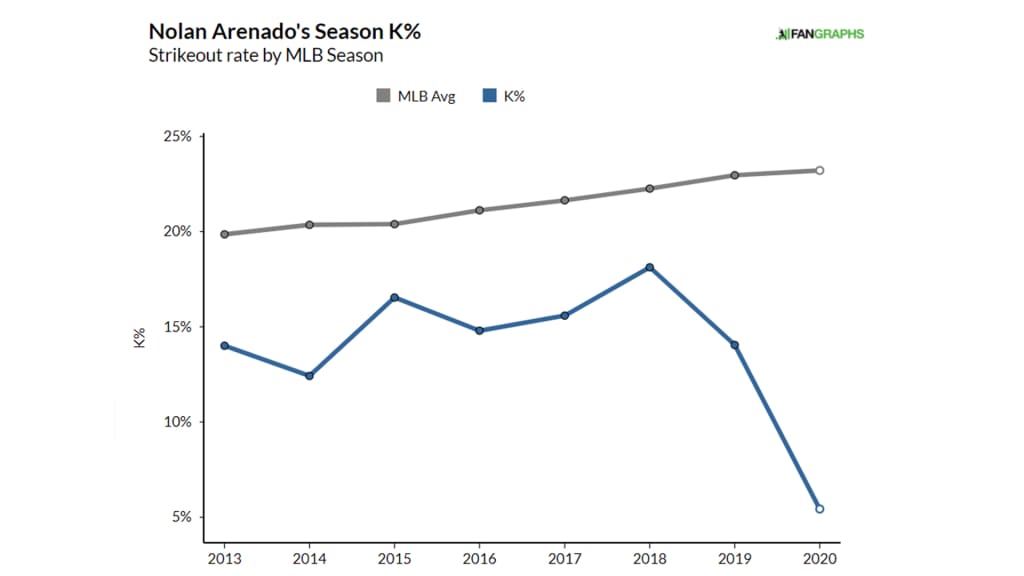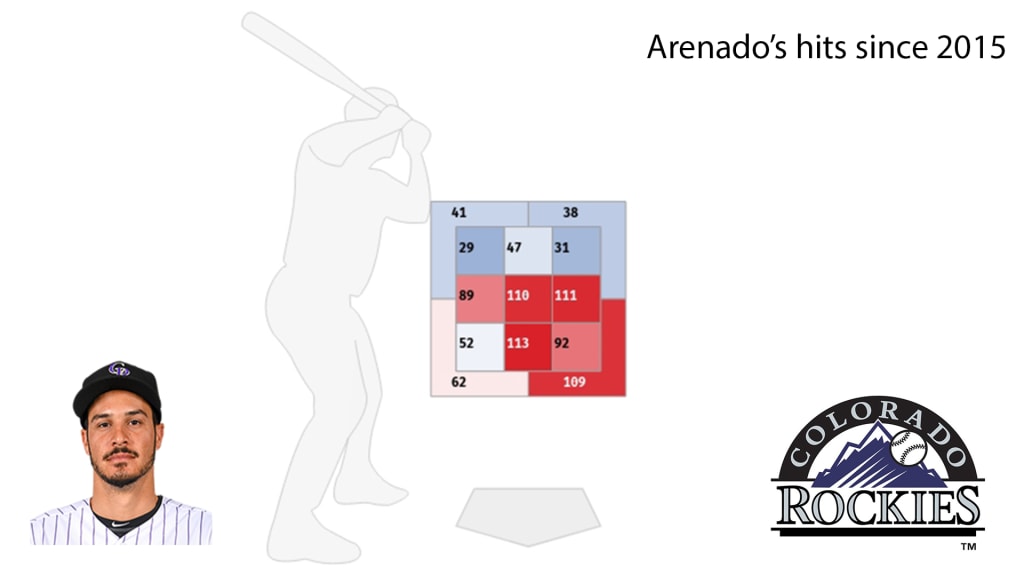
Nolan Arenado has become one of the Majors’ best strikeout hitters -- a notable improvement from years past -- yet he’s mired in the worst start of his career.
Wait, what?
Indeed, the oddities of this 2020 season have extended to the Rockies superstar, who is hitting .233/.281/.465 after going 1-for-4 in Monday’s 2-1 loss to the Astros and 1-for-12 over the weekend against Texas. On Sunday, Arenado struck out for the first time in two weeks, snapping a span of a career-best 49 plate appearances, which also remains MLB’s longest stretch of ’20.
So what gives?
Arenado has shown glimpses of his elite form, and his six homers trail only Trevor Story’s seven for the Rockies’ lead. But there’s no doubting that he hasn’t been the linchpin in the middle of Colorado’s lineup all season. These struggles were masked by a scorching start by Charlie Blackmon, who’s flirting with a .400 season, and starting pitching that is resembling its 2018 postseason form, which helped the Rockies surge to first place in the National League West through the first two weeks of the season.
But with Colorado dropping seven of its past nine and tumbling to four games behind the Dodgers, a skid like the one Arenado is in is the type that has become far more illuminated.
Here are three reasons why Arenado is slumping, and a few signs why the five-time All-Star can get back on track:
1) The good: That elite K rate
Let’s circle back to those strikeouts. Arenado has fanned just five times in 96 plate appearances this season, for a rate that is in Tony Gwynn territory. That two-week strikeout-less streak put Arenado near the top the MLB leaderboards for the lowest K rate in 2020, and it represents a significant improvement from his 14% rate in ’19 and 15.1% career rate. The dropoff from last season is the Majors’ fourth-best improvement among hitters who've put at least 25 balls in play.
Lowest strikeout rate, 2020
- Tommy La Stella: 5.9%
2) Nolan Arenado: 6.3%
3) Joey Votto: 8.1%
4) DJ LeMahieu: 8.9%
5-T) Corey Seager: 9.8%
5-T) Kyle Seager: 9.8%
This has been an improved trend for Arenado in each of the past two years, and it’s worth noting that this is happening while collective strikeout rates continue to rise.

Arenado has sold out strikeouts for power plenty in the past, but this newfound improvement isn’t exactly what he’s looking for.
“There are times where I’d rather strike out than just roll a ball over to short and third,” Arenado said recently. “I’d rather strike out with my ‘A’ swing than with my ‘D’ swing, where I roll it over on the ground and don’t strike out. Obviously, I don't like to strike out and those are empty at-bats. But at the same time, if I'm getting my ‘A’ swing off, that usually means my body is in a good position.”
So, if Arenado isn’t trying to avoid K’s at the expense of quality contact, then what else is going on?
2) The bad: His contact isn’t ideal
Arenado’s game has always been predicated on power. His 205 homers since 2015 are second-most in MLB to only Nelson Cruz’s 212. But he’s also blossomed into a legitimate contact hitter, having flirted with the National League batting title last season with a .315 average.
Yet, take away Arenado’s six homers, and he’s hitting just .175/.233/.200. Rockies manager Bud Black has said that Arenado has been getting “underneath” the ball too much lately, and evidence supports that assertion. Thanks to Statcast, we can quantify the quality of Arenado’s contact.
Arenado’s poor/under contact rate
2015: 28.4%
2016: 32.9%
2017: 30.8%
2018: 26.7%
2019: 30.6%
2020: 42.5% (highest in MLB)
Take a look at where Arenado has done his most damage, with a breakdown of where each of his hits since 2015 have come from:

Now, let’s look at how some balls in those areas are coming off his bat in 2020:
There’s evidence here suggesting Arenado is missing his “sweet spot” -- the part of the barrel that connects with a launch angle from 8-32 degrees and leads to damage. Statcast defines the sweet spot as 8-32 degrees, because that covers both the best range for home runs (24-32 degrees) and base hits (8-16 degrees).
Arenado’s average launch angle is up from a career 17 degrees to 23.8 degrees, which is typically in the line drive and fly ball range. But his swing is finding far more lift than the sweet spot, with nearly one fifth of his batted balls at 50 degrees or higher. League-wide, those balls have a .011 batting average -- basically a guaranteed out.
So, Arenado is avoiding K’s, yet it’s not correlating to good contact. Where does that leave us?
3) He’s also getting little to no luck
Arenado has long been a benefactor of playing his home games in Denver. Thanks to Coors Field’s thin air and expansive outfield, the Rockies’ offense collectively outkicks its coverage, more than any team. Colorado’s expected metrics (how they should fare) are typically much lower than their actual numbers over an entire season, even accounting for road games.
Arenado has been no outlier. But this year has been a different story.
Arenado’s actual vs. expected metrics, 2020
BA: .233 | .272
SLG: .476 | .528
wOBA: .305 | .345
Also revealing, Arenado has a ghastly .176 batting average on balls in play, which is fifth lowest in MLB, meaning that his contact isn’t yielding ideal results. For context, Blackmon (who was the hottest hitter on the planet until maybe last week) has an MLB-high .486 BABIP.
Steamer projections (widely viewed as among the most accurate to forecast future outcomes) suggest that Arenado will find his way, projecting that he’ll finish as a top 20 hitter. But for Arenado, expected metrics won’t directly yield hits, runs and -- above all -- wins.
Arenado understands what gets him into trouble, and he’s meticulous about correcting those mistakes. And, while he’s typically been a slow starter, it’s right around the 20-game mark that he begins to heat up -- except for this season.
Arenado through 21 games
2020: .233/.281/.465 (.746 OPS)
2019: .281/.337/.483 (.820 OPS)
Career: .298/.348/.565 (.913 OPS)
And this is 2020, where there are only 60 games for the Rockies to put backing to their assertion that a wildly disappointing ’19 was an outlier after consecutive postseason berths in ’17 and ’18. Arenado was an MVP finalist in that most recent trip to October, and Colorado will likely need him to begin performing like one if they hope to get back.
